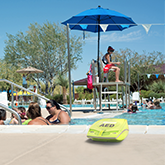Essential tools for swimming pool safety
With summer just around the corner and the weather heating up, many people will be heading to the local swimming pool to cool off. Swimming is a highlight of summer, but keep in mind that drowning is one of the top five causes of unintentional injury-related death in the United States1, and it is often associated with cardiac arrest.2

Sudden cardiac arrest (SCA) occurs when an electrical malfunction of the heart causes it to suddenly stop beating properly. SCA happens unexpectedly and can affect people of all ages, even children and teens. In a drowning victim, SCA occurs due to lack of oxygen in the bloodstream and an increase of lactic acid in the body, which directly effects the heart rate.
In an ideal world, everyone would be educated on how to respond in an SCA emergency – especially since a victim’s chance of surviving cardiac arrest drops by 10% for every minute without intervention.
Keeping members of your community safe is a top priority.
To ensure that your public swimming pool meets the safety needs of the community, it is important that all employees – including your recreational managers, lifeguards, and instructors – are trained to provide high-quality CPR and also receive AED training. For employees who have already been trained, make sure their AED and CPR certifications are up to date and comply with local pool safety regulations. With proper training, you and your staff can be confident that you are prepared for pool emergencies.
AEDs should be readily available to all lifeguards and the general public at all commercial pools. If an event should occur, follow these steps:
- Call 9-1-1
- Get the AED
- Start CPR
- Responders equipped with an AED should stay clear of any water
- If the victim is in the water, move him/her to a dry area
- Remove wet clothing and dry the victim’s chest before placing the pads
- Avoid getting the pads wet
- All rescuers and assistants should stay away from wet surfaces
Download our eBook, Getting to High-Quality CPR, to learn more about the importance of CPR. For our full product line, check out our product portfolio of Public Access AEDs.

Think ahead, plan ahead, and pledge to hold your pool to a higher safety standard this summer. Keeping families safe is the first step to fun in the sun!
1 National Drowning Prevention Alliance Website, ndpa.org/about/. Accessed 27 Feb 2018.
2“Drowning.” NEJM Website, www.nejm.org/doi/full/10.1056/NEJMra1013317. Accessed 7 Mar 2018.
3 Sasson C, Rogers MA, Dahl J, Kellermann AL. Predictors of survival from out-of-hospital cardiac arrest: A systematic review and metaanalysis. Circulation: Cardiovascular Quality and Outcomes. 2010b;3(1):63–81 (Sasson et al., 2010b).
